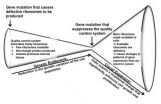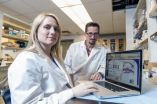(Press-News.org) Johns Hopkins researchers say that an experimental anticancer compound appears to have reversed behaviors associated with schizophrenia and restored some lost brain cell function in adolescent mice with a rodent version of the devastating mental illness.
The drug is one of a class of compounds known as PAK inhibitors, which have been shown in animal experiments to confer some protection from brain damage due to Fragile X syndrome, an inherited disease in humans marked by mental retardation. There also is some evidence, experts say, suggesting PAK inhibitors could be used to treat Alzheimer's disease. And because the PAK protein itself can initiate cancer and cell growth, PAK inhibitors have also been tested for cancer.
In the new Johns Hopkins-led study, reported online March 31 in the Proceedings of the National Academy of Sciences, the researchers found that the compound, called FRAX486, appears to halt an out-of-control biological "pruning" process in the schizophrenic brain during which important neural connections are unnecessarily destroyed.
Working with mice that mimic the pathological progression of schizophrenia and related disorders, the researchers were able to partially restore disabled neurons so they could connect to other nerve cells.
The Johns Hopkins team says the findings in teenage mice are an especially promising step in efforts to develop better therapies for schizophrenia in humans, because schizophrenia symptoms typically appear in late adolescence and early adulthood.
"By using this compound to block excess pruning in adolescent mice, we also normalized the behavior deficit," says study leader Akira Sawa, M.D., Ph.D., a professor of psychiatry and behavioral sciences at the Johns Hopkins University School of Medicine. "That we could intervene in adolescence and still make a difference in restoring brain function in these mice is intriguing."
For the mouse experiments, Sawa and his colleagues chemically turned down the expression of a gene known as Disrupted-in-Schizophrenia 1 (DISC1), whose protein appears to regulate the fate of neurons in the cerebral cortex responsible for "higher-order" functions, like information processing.
In studies of rodent brain cells, the researchers found that a DISC1 deficit caused deterioration of vital parts of the neuron called spines, which help neurons communicate with one another.
Reduced amounts of DISC1 protein also impact the development of a protein called Kalirin-7 (KAL7), which is needed to regulate another protein called Rac1. Without enough DISC1, KAL7 can't adequately control Rac1 production and the development of neuronal spines. Excess Rac1 apparently erases spines and leads to excess PAK in the mice.
By using FRAX486 to reduce the activity of PAK, the researchers were able to protect against the deterioration of the spines caused by too little DISC1, halting the process. This normalized the excess pruning and resulted in the restoration of missing spines. They were able to see this by peering into the brains of the mice with DISC1 mutations on the 35th and 60th day of their lives, the equivalent of adolescence and young adulthood.
Sawa, who is also director of the Johns Hopkins Schizophrenia Center, cautions that it has not yet been shown that PAK is elevated in the brains of people with schizophrenia. Thus, he says, it is important to validate these results by determining whether this haywire PAK cascade is also occurring in humans.
In the mice, the researchers also found that their behavior improved when PAK inhibitors were used. The mice were tested for their reaction to noises. There is a neuropsychiatric phenomenon in which any organism will react less to a strong, startling sound when they have first been primed by hearing a weaker one. In schizophrenia, the first noise makes no impact on the reaction to the second one.
The mice in the study showed improvements in their reactions after being treated with the PAK inhibitor. The drug was given in small doses and appeared to be safe for the animals.
"Drugs aimed at treating a disease should be able to reverse an already existing defect as well as block future damage," Sawa says. "This compound has the potential to do both."
INFORMATION:
Other Johns Hopkins researchers involved in the study include Akiko Hayashi-Takagi, M.D., Ph.D.; Yoichi Araki, Ph.D.; and Richard L. Huganir, Ph.D. Other researchers include those from the Center for Disease Biology and Integrative Medicine at the University of Tokyo; PRESTO the Japanese Science and Technology Agency; the University at Buffalo; and Afraxis Inc., which makes FRAX486.
The work was supported by grants from the National Institutes of Health's National Institute of Mental Health (MH-084018, MH-94268, MH-069853, MH-085226, MH-088753 and MH-092443), the Stanley Foundation, the RUSK Foundation, the S-R Foundation, the National Alliance for Research on Schizophrenia and Depression, Johns Hopkins Medicine's Brain Science Institute, Maryland Stem Cell Research Fund, the Japan Society for the Promotion of Science, PRESTO and the Howard Hughes Medical Institute.
Experimental cancer drug reverses schizophrenia in adolescent mice
2014-03-31
ELSE PRESS RELEASES FROM THIS DATE:
Possible explanation for human diseases caused by defective ribosomes
2014-03-31
Ribosomes are essential for life, generating all of the proteins required for cells to grow. Mutations in some of the proteins that make ribosomes cause disorders characterized by bone marrow failure and anemia early in life, followed by elevated cancer risk in middle age. These disorders are generally called "ribosomopathies."
How can ribosomopathies first appear as diseases caused by too few cells, but later turn into diseases caused by too many cells? This paradox has puzzled the scientific community for years. A new study, which uses a genetic approach to examine ...
Oxygen depletion in the Baltic Sea is 10 times worse than a century ago
2014-03-31
This news release is available in German. After several years of discussions, researchers from Aarhus University (Denmark), Lund University (Sweden) and Stockholm University (Sweden) have determined that nutrients from the land are the main cause of widespread areas of oxygen depletion. The results were published on 31 March in the prestigious American journal Proceedings of the National Academy of Sciences.
Nutrients are the villain
The deepest areas of the Baltic Sea have always had a low oxygen content. The inflow of fresh water is actually limited by low thresholds ...
Scientists understand how E. coli clone has become globally distributed
2014-03-31
Scientists have for the first time come closer to understanding how a clone of E. coli, described as the most important of its kind to cause human infections, has spread across the world in a very short time.
E. coli clone ST131 is one of the leading causes of urinary tract and blood stream infections and has crossed the globe at a rapid rate. Worryingly, members of this clone are becoming more resistant to antibiotics. As an indication of scale, more than half of all women will suffer a urinary tract infection at least once in their lives. An international team of scientists, ...
Researchers announce first phononic crystal that can be altered in real time
2014-03-31
Using an acoustic metadevice that can influence the acoustic space and can control any of the ways in which waves travel, engineers have demonstrated, for the first time, that it is possible to dynamically alter the geometry of a three-dimensional colloidal crystal in real time.
The colloidal crystals designed in the study, called metamaterials, are artificially structured materials that extend the properties of existing naturally occurring materials and compounds. The research by academics from the University of Bristol's Department of Mechanical Engineering is published ...
Weaker gut instinct makes teens open to risky behavior
2014-03-31
DURHAM, N.C. -- Making a snap decision usually means following your initial reaction -- going with your gut. That intuitive feeling sprouts from the limbic system, the evolutionarily older and simpler part of the brain that affects emotion, behavior and motivation.
But during adolescence, the limbic system connects and communicates with the rest of the brain differently than it does during adulthood, leaving many adolescents vulnerable to riskier behaviors, according to Duke University researchers.
"We know adolescence is a time of profound social change. It's also ...
New tool helps young adults with sickle cell disease in the transition to adult care
2014-03-31
(Boston) – Child and adolescent hematologists at Boston Medical Center (BMC) have developed a tool to gauge how ready young adults with sickle cell disease are for a transition into adult care. In a new article for the Journal of Pediatric Hematology/Oncology, Amy Sobota, MD, MPH, and her collaborators have shown that a questionnaire geared to the needs of young adults with sickle cell disease can pinpoint areas of need before the patient goes into an adult clinic.
BMC's sickle cell disease transition clinic, which is unique in Boston, was established in 2008 and serves ...
Vibration may help heal chronic wounds
2014-03-31
Wounds may heal more quickly if exposed to low-intensity vibration, report researchers at the University of Illinois at Chicago.
The finding, in mice, may hold promise for the 18 million Americans who have type 2 diabetes, and especially the quarter of them who will eventually suffer from foot ulcers. Their wounds tend to heal slowly and can become chronic or worsen rapidly.
Timothy Koh, UIC professor of kinesiology and nutrition in the UIC College of Applied Health Sciences, was intrigued by studies at Stony Brook University in New York that used very low-intensity ...
Kinder, gentler med school: Students less depressed, learn more
2014-03-31
ST. LOUIS -- Removing pressure from medical school while teaching students skills to manage stress and bounce back from adversity improves their mental health and boosts their academic achievement, Saint Louis University research finds.
Stuart Slavin, M.D., M.Ed., associate dean for curriculum at SLU School of Medicine, is the lead author of the paper, which is published the April edition of Academic Medicine. The problem of depression among medical school students is significant, Slavin said, affecting between 20 and 30 percent of medical students in the U.S., and potentially ...
Poor sleep quality linked to cognitive decline in older men
2014-03-31
DARIEN, IL – A new study of older men found a link between poor sleep quality and the development of cognitive decline over three to four years.
Results show that higher levels of fragmented sleep and lower sleep efficiency were associated with a 40 to 50 percent increase in the odds of clinically significant decline in executive function, which was similar in magnitude to the effect of a five-year increase in age. In contrast, sleep duration was not related to subsequent cognitive decline.
"It was the quality of sleep that predicted future cognitive decline in this ...
Psychological factors turn young adults away from HIV intervention counseling
2014-03-31
PHILADELPHIA (March 31, 2014) – Keeping young people in human immunodeficiency virus (HIV) prevention programs is a major goal in reducing the incidence of HIV, and multi-session interventions are often more effective than single-sessions. But according to a new study from the Annenberg School for Communication, the way these programs are designed and implemented may turn off the very people they are trying to help.
The study, "Motivational barriers to retention of at-risk young adults in HIV-prevention interventions: perceived pressure and efficacy," is published in ...




